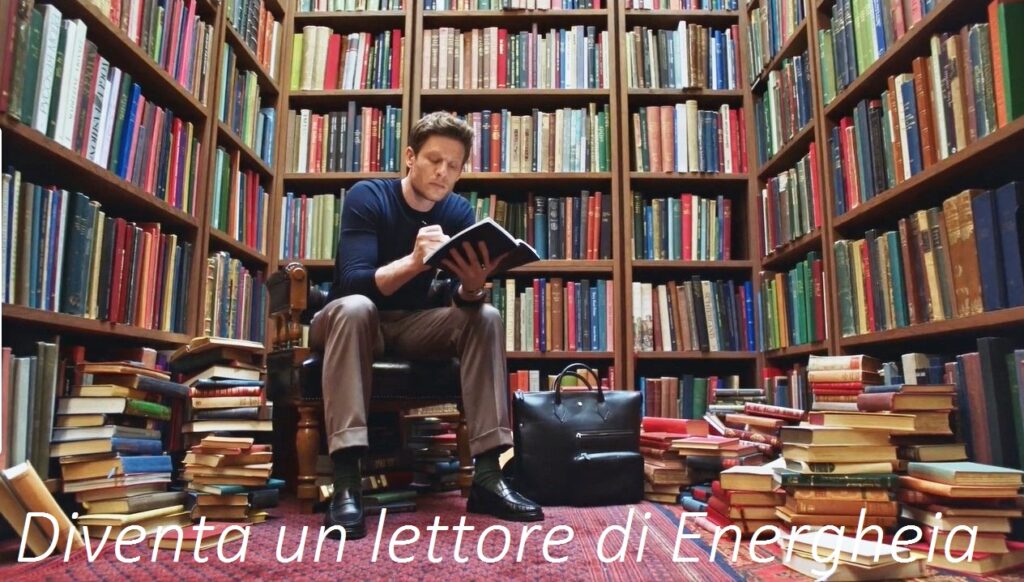Matera – 2019. The City of life and Death
ULF PETER HALLBERG, Writer
Coordinator Energheia France Prix

hFor Felice Lisanti and Energheia
When my first novel, Lo sguardo del flâneur, was published in Italy in 2002, my publisher received a letter from a professor of Psychiatry, who wanted me to come and speak about “Suicide and Nihilism in the Literature and Culture of the 19th and the 20th century”, because he had read my novel. Somehow I felt guilty. My thoughts should be presented at a conference with psychiatrists from all over the world, he wrote, taking place in Ravenna. Emilia Lodigiani, my publisher, warned me, telling me I would lose months and probably my sanity on that work, and I also had no clue about the background of this intention, that I, a late Romantic, should write about Anguish and Death, but I could not resist the challenge. So I worked on the subject for a longer period and eventually spoke in Ravenna, about all which is strange to me: the situation of “No hope!”, of giving up, about the forced and hard ending, when all is despair. I put in as much hope as I could – as a paradox. The six hundred psychiatrists listened carefully to me at a huge convention centre, and I felt that at least a bunch of them perhaps thought their patients could now somehow be treated by literature, instead of the usual methods of injections or pills. I felt some psychiatrists wanted to give it a chance. So I made friends with professors who had written dictionaries of Suicide, and some of what I heard at the conference went straight into my own writing afterwards. I really felt grateful to the man who had invited me, Professor Matteo Magnante. Especially for the information that there is a special treatment at Salute mentale, which lets the suicidal patients play soccer every day to learn about coping with life. Passing a shot, delivering – life! Matteo Magnante, the professor himself, had one strong focus, he told me, against illness, suicidal tendencies and all evil, and that was a city in the South, a city I should see, a city he wanted to take me to, the City of Life and Death – Matera.
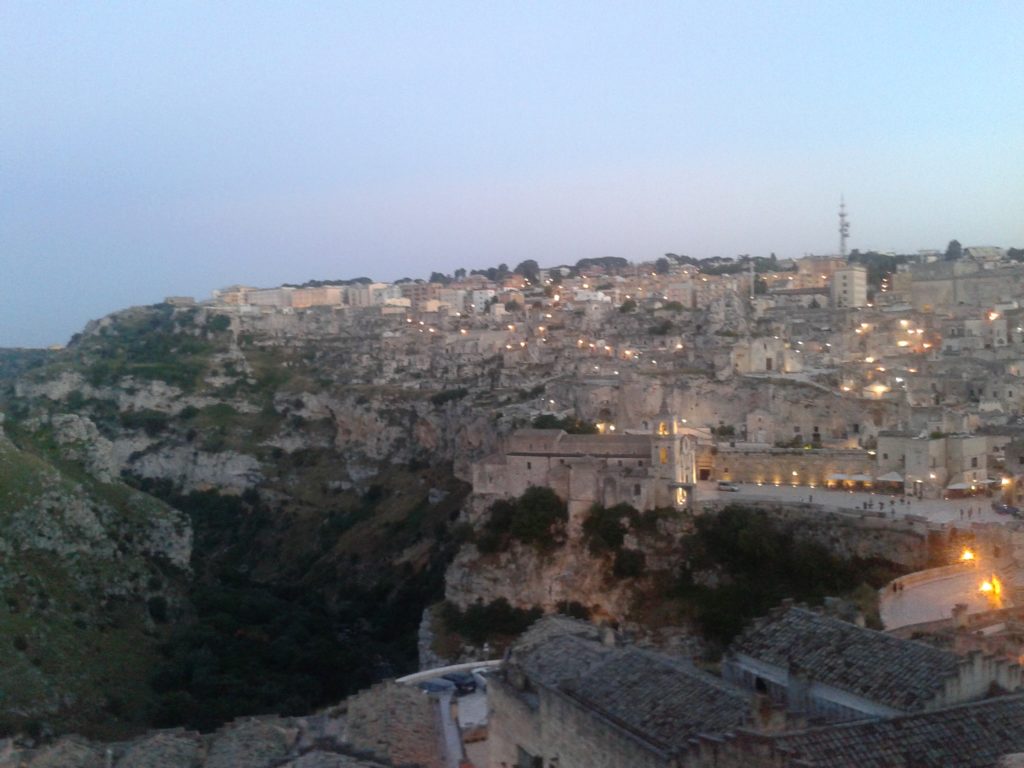
For many years I was invited by Professor Magnante to spend summer in Matera, but my sons like tennis and the Nordic coast at Öresund, not people who talk to their father about literature, so unfortunately we never came. Nevertheless, Professor Magnante found an ally, the cultural organization Energheia, and in September 2014 I was officially invited to Matera as a writer to a reading and a dialogue, based on my novel Trash europeo, published by Iperborea in 2013.
My guide was Felice Lisanti from Energheia, and I was presented at Palazzo Lanfranchi by Matteo Magnante and Maria Nolet. On that September evening I really made friends with Matera. I learnt how to walk slower, because of the heat, I learnt to think more and hopefully deeper, inspired by the city, and I felt I understood some more about generosity. The three of them were sparkling figures, pure openness – and so were the friends surrounding us. In the night afterwards, I felt that there was a special wind talking to me about what is important in life and what is not, the darkness of the Murgia valley and the beautiful lightning of Matera teaching me things, and when the heat dissolved into a fresh clear atmosphere at night, I felt – I guess just like everyone in Matera – that there are moments when we can be a bit like Socrates ourselves. It’s all about the place, and the refreshing air that can transform us.
There is of course always a prize to everything, so the next day I was asked by Felice Lisanti, if I could not collaborate with Energheia, and make it possible for young people in France to write short stories and let a winner come to Matera each year, to feel out the City of Life and Death, just as I had done. I agreed that this suggestion had a certain logic to it, and that it could be a solution on how to save nations when they are in deep trouble. Together with my colleague and friend, Professor Sylvain Briens at Études Nordiques, Sorbonne Université, I founded Energheia France, and we also created a ceremony for the winners at the Sorbonne – inviting Felice Lisanti to it – but I did not realize yet how much this collaboration with Matera would come to mean – to me.
Before I tell you this, I want to share three passages from my students about their experience of Matera. Because this makes the work important, the energy that all my students show, and the experiences they make and share when writing their stories – and for some lucky ones, when they come to Matera.
So here are my three winners, in their own words, and then I will continue:
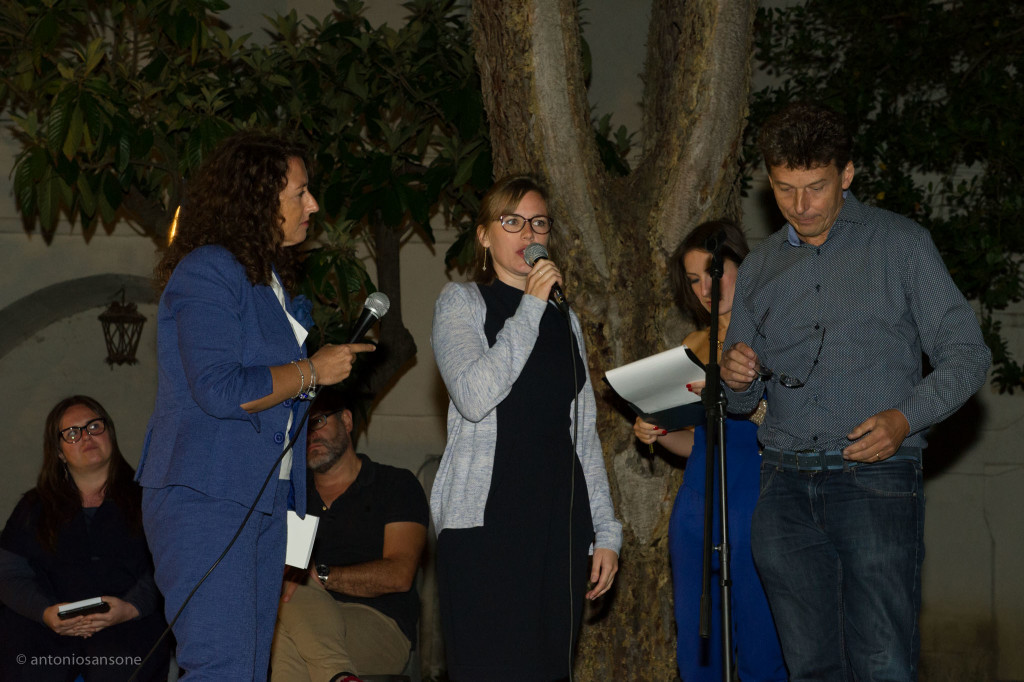
Annelore Herrmann 2016
Mercredi 15 septembre. L’aéroport de Bari, 19h04.
Je posais mes pieds sur cette terre méditerranéenne avec plein d’idées dans la tête et ma plus belle robe d’été dans ma valise. J’étais venue pour la cérémonie du Premio Energheia.
Le lendemain, le grand jour était arrivé. La remise de prix était annoncée depuis très très longtemps pour samedi, 17 septembre. Il était 8 heures du soir, beaucoup d’amateurs de culture italiens étaient venus au jardin du Musée Ridola. Les places entourées par des cyprès et des oliviers étaient rapidement occupées.
Tous les invités attendaient le grand moment avec impatience. Ulf Peter Hallberg, l’écrivain suédois qui encadrait le projet en France, me mettait au courant des derniers détails pour la remise de prix.
Finalement, la présentatrice prenait la parole au micro et c’était le début d’un moment très festif.
Mathis Ferroussier 2017
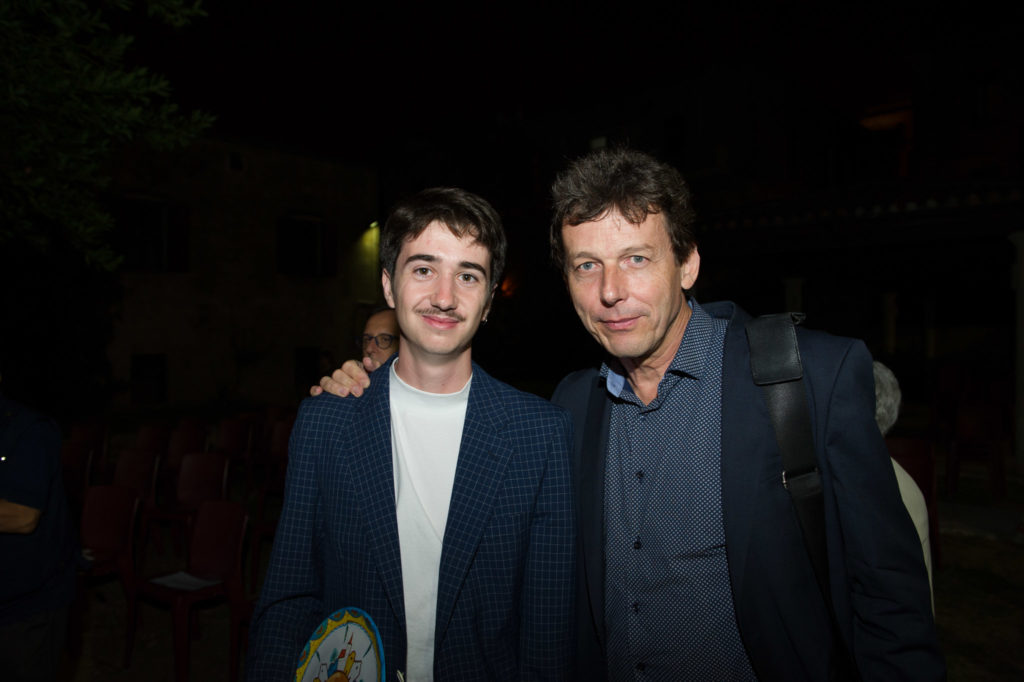
M’y voilà donc. Et j’ai beau y être pour de bon j’ai du mal à le comprendre. Ce n’est souvent que la nostalgie des instants passés qui nous rappelle à leur valeur. Le moment présent, trop dénudé, trop étincelant, trop aveuglant, attire notre œil mais nous force à détourner de lui notre regard. Mais m’y voilà donc et me voilà qui tente de ne pas laisser cet instant m’échapper.
Tournoyer dans les ruelles folles, repasser cent fois devant les mêmes cafés, les mêmes boutiques, entrer dans chacune des dizaines d’églises où des veuves éplorées se signent théâtralement devant le corps d’un Christ miséricordieux ; entrer dans les immeubles aux portes grandes ouvertes et monter jusque sur des toits inconnus pour contempler la ville ; laisser la nuit tomber et surprendre, au milieu des amas anarchiques de maisons taillées dans la roche, des couples impudiquement enlacés, protégés par l’obscurité ; dans la nuit, voir la ville de roche se transformer en une luxuriante oasis de lumière qui charge chaque silhouette d’une beauté tragique. Voir la brume s’élever des gorges qui déchirent la ville en deux et recouvrir ceux qui bravent l’obscurité d’une mince pellicule d’eau ; voir les vers noirs par milliers glisser sur la pierre humide, amis bienveillants des flâneurs insomniaques. Et, lové dans le silence, posté au plus haut de la ville, près des maisons troglodytiques restées inhabitées, humer la senteur âcre et entêtante d’un lieu d’où sortent chaque nuit les fantômes de centaines d’années d’histoire.
Emma Reinhardt 2018
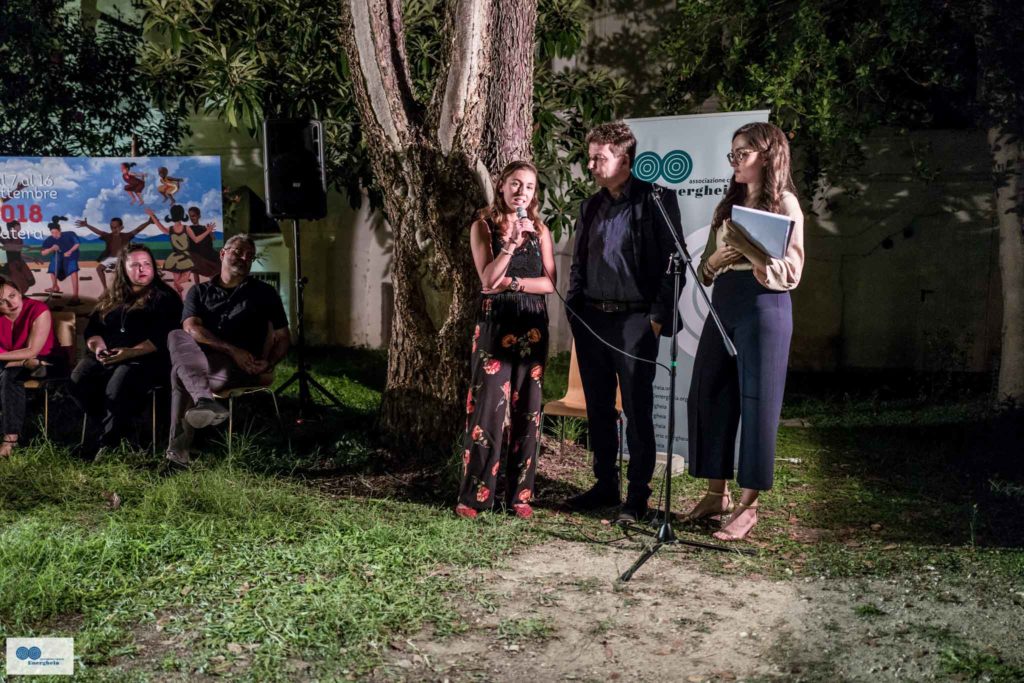
Le temps n’a pas d’emprise sur Matera. Ici, on se moque des aiguilles qui dansent encore et encore à vous en donner le tournis. On rit au nez des alarmes, des rendez-vous, des contraintes et des horaires. Une sorte de douce rébellion anime le cœur des habitants qui vivent au rythme du soleil et font fi des conventions… Je gobe mon dernier petit bout de nuage caffeiné. Bientôt, la machine va se remettre en marche. Les grains vont se bousculer aux portes du temps et tout reprendra son cours.
Maudite mouche. Elle me tourne autour depuis bientôt quatorze minutes et trente-deux secondes. Elle vient m’annoncer la fin de cette parenthèse hors du temps, hors de tout, hors de moi-même. Pendant un court instant, j’étais sortie de mon corps, j’étais entrée dans un état second, la transcendance vide de Friedrich peut-être, à la recherche de quelque chose, de tout et de rien à la fois. Comment un rayon de soleil, quelques vieilles pierres et un cappuccino peuvent-ils nous transporter si loin? J’avais atterri dans les tréfonds de la mise en abyme, un voyage au cœur du voyage. Je préfère ne pas me poser trop de questions et croire en la magie du lieu. Il y a peu, je posais mes valises en terre inconnue, mais quand je quitte cette terrasse de café, bien que rien ne m’y autorise, j’ai le sentiment, qu’ici, c’est aussi ma-terra.
*
I have to confess that in film Italian neorealism beats everything – before and after it appeared. Directors like De Sica, Rossellini, Visconti, Ettore Scola and the Taviani Brothers are my heroes. I’ve seen Scola’s C’eravamo tanto amati eight times, Rosselinis Viaggio in Italia makes me write things like: ”Rossellini’s masterpiece is about love and the struggle for the truth. The story is very simple, the screenplay bare bones.” I like that kind of stuff, I think we should search for some truth. John Lennon sang about this in a good way: ”I’m sick and tired of hearing things from uptight-short sighted-narrow minded hypocritics: All I want is the truth. Just give me some truth.”
The closest I’ve come to Italian Neorealism is Matera. Each time I visit, I feel like I’m in one of those neorealistic films. In the beautiful garden of Museo Domenico Ridola, when Energheia announces the prizes and the winners, I’m with Ettore Scola. At night with friends from different countries, or at breafkast on a terrace overlooking the Sassi, I’m with Luchino Visconti. Not to mention all my lonely walks through those pebbled streets at night, then I’m really with Roberto Rossellini. And when people stop me in the streets, just to talk, and I don’t know exactly who they are, just that we belong to Energheia, they make me feel I’m really part of Matera – then I’m with Vittorio De Sica. Finally, when last time, after years of urging, I was allowed to accompany Felice Lisanti, ambulatorio veterinario, on his tour in the mountains at six o’clock in the morning to vaccinate the animals, I was with the Taviani Brothers – we were still starring in Padre Padrone, together with the peasants and the sheep. This is all part of Energheia, the different workmen and women, the helping hands, this is the quality of a unique touch on Life and Literature. Felice Lisanti’s and Energheia’s attitude remind me of John Lennon: Friendship and Good Fun! And there is something sacred to all this and to Matera.
I feel the city itself constructs meaning by its athmosphere, its people and the silence at night under the big black sky. This is why I’m making The Beatles perform in Matera on September 22, 2019, as if John and George are not dead, but here with us, to help us cope with history. I want them to address us like John did when he was recording ”Stand by Me” in New York and was asked to greet the people in England. He did so by saying: ”I just want to say hello to you folks back in England…” Then he stared into the camera, with that boyish look, continuing: ”How’ya doing folks?” The Beatles in Matera will be surrounded by voices from houses of stone, the darkness of the valley, the silence in the streets, the steps that lead to points where you can really see life as it can be, in its best moments, like up at the wall in front of the Cathedral, where at night people come to talk and hug and kiss, in front of the silhouette of the city, a place where you can forget about yourself, your troubles, even about time itself, and take it in, the night, the moon, life, death, the young, a neck, a chin, a hand – the grace and beauty of it all, just being – in Matera.

